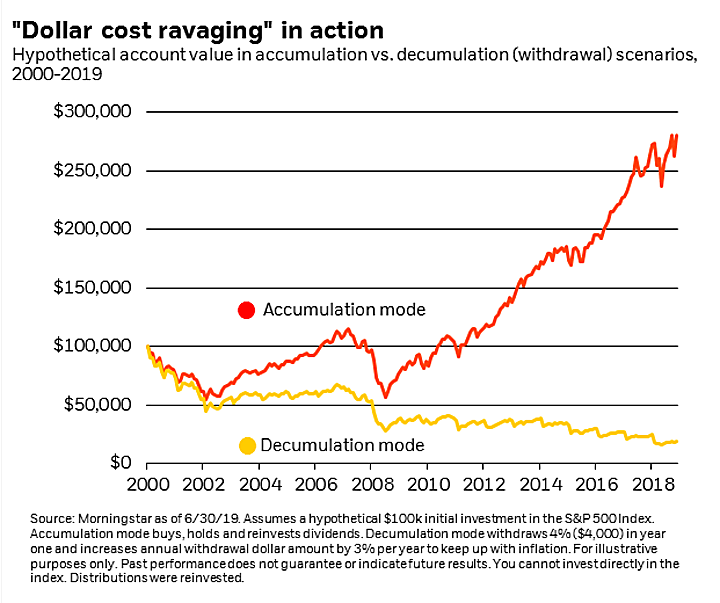 The last 10 years of stock market returns have been pretty remarkable. If you invested $100,000 in the S&P 500 in the year 2000 and held it though the dot-com crash and financial crisis, you would be closing in on $300,000 today. However, if you retired in 2000 with a portfolio invested in the S&P 500 and used a 4% withdrawal rate (increasing each year by 3% for inflation), your nest egg would less than $50,000 and on a path to zero!
The last 10 years of stock market returns have been pretty remarkable. If you invested $100,000 in the S&P 500 in the year 2000 and held it though the dot-com crash and financial crisis, you would be closing in on $300,000 today. However, if you retired in 2000 with a portfolio invested in the S&P 500 and used a 4% withdrawal rate (increasing each year by 3% for inflation), your nest egg would less than $50,000 and on a path to zero!

This stark difference between accumulation and withdrawal modes is illustrated by the chart above, taken from the Blackrock Blog post . “Dollar-cost ravaging” is also known as “sequence of return risk”, as explained in the this quote:
Investors have probably heard the term “dollar-cost-averaging,” where you make regularly timed investments to smooth out the risk of “buying high.” Retirees tend to do the opposite. Instead of putting money into their portfolio, they take it out with a regular cadence in the form of income. “Dollar-cost-ravaging” occurs when the market loses value while you’re taking withdrawals, especially in the early years of retirement. Because money is coming out rather than going in, it’s harder for the retiree to recover their losses when markets rebound. We even saw this during one of the most successful bull markets in our history over the past decade. The sequence of returns matters, and the biggest challenge is a bear market early in your retirement.
Unfortunately, there is no easy solution to this problem. This is what the article offers: “Striking the right balance to limit your losses in a declining market is just as important as capturing growth when the market is strong.” In other words, don’t hold too much in stocks, but also not too little. You can more easily weather a recession when you are still working and saving then when you are spending it down. I think more important advice is that you should be ready to withdraw less money out of your portfolio if the market tanks early on in your retirement withdrawal phase. Don’t follow a rigid withdrawal rule from some academic study into oblivion!
“The editorial content here is not provided by any of the companies mentioned, and has not been reviewed, approved or otherwise endorsed by any of these entities. Opinions expressed here are the author’s alone. This email may contain links through which we are compensated when you click on or are approved for offers.”
from .
Copyright © 2019 MyMoneyBlog.com. All Rights Reserved. Do not re-syndicate without permission.